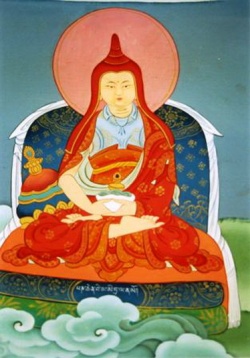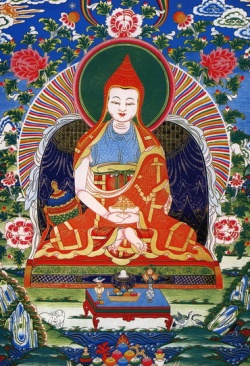A Preliminary Note on Vimalamitra's Aural Lineage
Up until now, Longchenpa's (1308-1364) Tshig don mdzod or Treasury of Subjects has taken the pride of place as the definitive system of exegesis of the so-called Dzogchen "snying thig" tradition derived from the seventeen tantras. David Germano's 1992 dissertation, Poetic thought, the intelligent Universe, and the mystery of self: The Tantric synthesis of rDzogs Chen in fourteenth century Tibet, was certainly a milestone in the study of this topic, but leaves much to be desired in terms of exposing the origins of this system of analysis of the man ngag sde class of tantras.
Fortunately, we are now in a better position than we were in 1992. Several seminal commentaries on tantras such as the sgra thal gyur and so on, have come to light, which are now being critically edited by native scholars such as Chogyal Namkhai Norbu and so on.
We also have had the good fortune of the publication of a 12th century text authored by one mKhas pa Nyi 'bum, the son of Zhang ston bkra shi rdo rje, called the rdzogs pa chen po tshig don bcu gcig pa bzhugs so (bod ljongs mi dmangs dpe skrun khang; lha sa; 2008) or The Eleven Subjects of The Great Perfection. We have also the good fortune of the publication of The Aural Lineage of Vimalamitra (rgod kyi ldem 'phru can. dgongs pa zang thal. TBRC W18557. 4: 187 - 406. simla: thub bstan rdo rje brag e wam lcog sgar , 2000).
In regards to the third text mentioned above, The Aural Lineage, this latter text is a slightly augmented recension with interpolations of supplementary citations and brief summaries into the original text authored by Nyi 'bum. Presented as a dialogue with King Trisong Detsen at Chimpu, apart from the introduction and a couple of scene specific interpolations, it presents a version of the Nyi 'bum text in its entirety with differences accountable by differing manuscript traditions and scribal errors. In several places where there is a difference between The Eleven Subjects and the Aural Lineage they are resolved by examining the same passages presented in the Treasury. In some cases sense can be restored to passages in the Eleven Topics with the Aural Lineage.
Moreover, the citations attributed to Vimalamitra in both the Treasury and the Aural Lineage find their origin in Nyi 'bum's Eleven Subjects.
Further, we can understand that at least one of the major commentaries on the seventeen tantras was present during the time of Nyi 'bum from which he must have derived his own presentation of the eleven topics i.e. the eigth and final chapter of the commentary of The String of Pearls Tantra attributed to Vimalamitra; the colophon of which notes that it was transmitted by Nyi 'bums's nephew, Guru Jo 'ber to one Gru gu Jo 'bum.
Thus, with the publication of the latter two texts, we can now triangulate the position of The Treasury of Subjects. Germano's thesis lends the impression that The Treasury of Subjects is a unique contribution of Longchenpa to the field of Dzogchen exegesis. But in fact, for its subject matter, The Treasury of Subjects is wholly dependent on Nyi 'bum's earlier text, both in terms of the general sequence of citations and of lifting entire passages or reworking entire passages. Thus, Nyi 'bum's seminal text, The Eleven Subjects of The Great Perfection provides the grand outline upon which the scholastic exegesis of the entire later Nyinthig tradition depends. It was clearly the main text used to teach the general outline of snying thing used up until the time of Kumararaja and it is absolutely certain that The Eleven Subjects was the text that Longchenpa had in front of him when he was composing his ]]Treasury of Subjects]].
While there is a great deal more that could be said about these three texts, and will be said about them in my forthcoming translation of The Aural Lineage, for now it is sufficient to note that there are numerous interesting questions about the transmission of Nyi 'bum's text, the relationship of the two core texts of the mkha' 'gro snyin thig to it, the transmission of the Eleven Subjects to Rigzin Godem (1337 - 1409, revealor of the dgongs pa zang thal), his rennovation of the text as a dialogue between Pandita Vimalamitra and Trisong Detsen, the subsequent eclipse of The Eleven Subjects in favor of the Treasury (a text at least four times in length), and so on.
One ready answer is that the Treasury contains responses to 14th century scholastic objections to Dzogchen (an overwhelming concern of Longchenpa) whereas The Eleven Subjects was transmitted in a close circle of disciples with very little ouside contact. Hence the polemics presented in the latter, such as there are, mainly consist of a condensed review of different theories of the basis which are presented in exhaustive detail in the fifth chapter of the exhaustive commentarary on the Tantra of the Six Dimensions of Samantabhadra, attributed also to Vimalamitra. Further, Longchenpa is clearly writing with a number of desiderata in mind such as cleaning up and/or omitting incorrect citations or citations he cannot readily identify in Nyi 'bum's text, and so on, as well as elaborating the eleven subjects with further relevant citations from texts indirectly referenced in Nyi 'bum. It is also interesting to note that Nyi 'bum's text has been replaced in the Vima Snying thig with a quasi-treasure text authored by Longchenpa that just covers the bare bones of the eleven subjects sans citations.
It is important to point out also that Longchenpa does move a section concerning the formation of the body to the second topic heading, the delusion of sentient beings, from its place in the Eleven Subjects/Aural Lineage in the fifth topic, the pathway of wisdom. He adds a detailed discussion on the distinction between the all-basis and the dharmakāya which is not found in either of the latter two texts. There are other features of the Treasury of Subjects that mark it for special consideration as well, such as Longchenpa's grounding of the third subject, the treatment of the basis or seed of buddhahood present in all sentient beings explicitly within the tathāgatagarbha corpus of sūtras, and tagging the eleven subjects with the same denominator, "rdo rje gnas", or "vajrapada", an evident homage to the Uttaratantra of Maitreyanatha. While Longchenpa clearly upheld his understanding of so-called Prasanga Madhyamaka as the definitive expression of Mahāyāna view, it is also absolutely correct to state that Longchenpa held the tathāgatagarbha corpus of sūtras as the definitive expression of Mahāyāna given his separate treatment of this doctrine in the [[sgrub mtha' mdzod and in the Treasury of Subjects.
One might also speculate that the earlier text was rennovated by Rigdzin Godem and included in the dgongs pa zang thal collection because it represents an earlier tradition than that of Longchenpa, has a less cluttered presentation, is not as long, is easier to teach and so on, and as such does indeed represent the basis of the authentic aural lineage of Vimalamitra.
However, as indicated above, the study of the three texts concerning the eleven topics authored by Longchenpa, as well as the dgongs pa zang thal's Aural Lineage, is not complete without reference to the earliest extant text we have on the subject, The Eleven Subjects of The Great Perfection. Therefore, Nyi bum's text occupies a critical point in the history of the evolution of the snying thig tradition and should not be overlooked.

